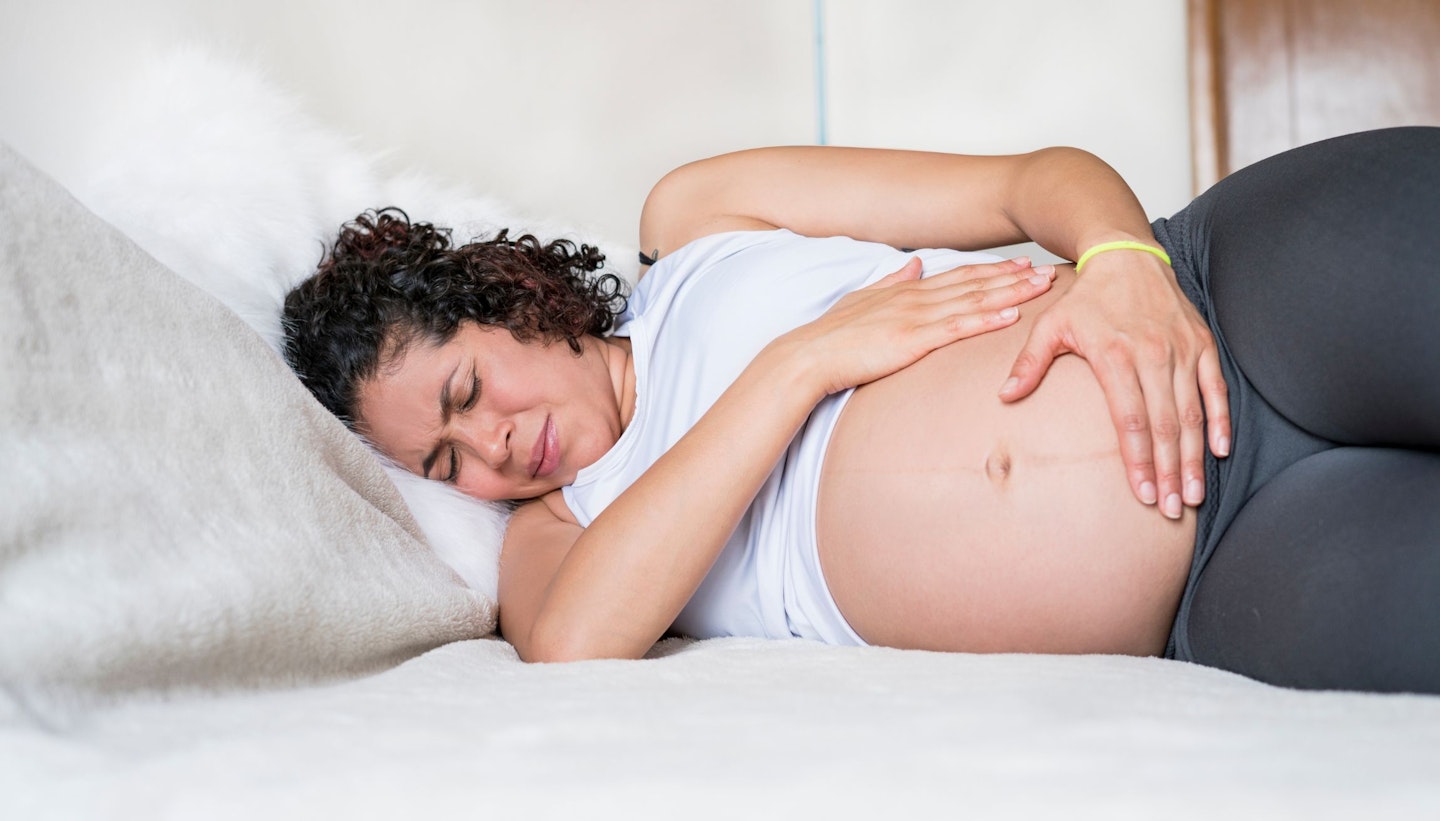
Medically Reviewed by: Lesley Bland BA (Hons), BSc (Hons) Midwifery Studies
Pregnancy can be pretty rough. From puffed-up ankles, to backaches, sore boobs, and the not-so-glamorous reality of morning sickness… it’s a lot. And just when you think it can’t get more uncomfortable, some mums-to-be start feeling pain in a very personal area, yep, your pelvis.
If you're waddling, struggling to roll over in bed, or finding that getting in and out of the car makes you wince, Pelvic Girdle Pain (PGP), previously referred to as Symphysis Pubis Dysfunction (SPD) could be to blame. Don’t worry, we’ve got you covered with everything you need to know, straight from the experts.
What is Pelvic Girdle Pain (PGP)?
Pelvic Girdle Pain (PGP), is pain in your pelvic area caused by your joints moving more than usual. It’s due to your ligaments softening in preparation for birth.
Pregnant women may experience pain or discomfort in the pelvic region during pregnancy. This is known as symphysis pubis dysfunction (SPD) or pelvic girdle pain (PGP),” explains Dr. Deborah Lee, a former NHS GP and sexual health specialist, now working as a medical writer.
“The symptoms of PGP arise from the anatomy of the pelvis and the natural changes that occur as a pregnancy advances,” she adds.
As your pregnancy progresses, the ligaments around your pelvis soften (thanks to the hormone relaxin), which is great for labour but not so great for walking, standing, or even turning over in bed.
“The left and right side of the pelvis are held together at the front in a central joint called the symphysis pubis (SP),” says Dr. Deborah. “The ligamentous attachments of the pelvic bones soften in pregnancy, allowing the pelvis to expand and to widen to allow for childbirth.”
How common is PGP in pregnancy?
Surprisingly common! Although figures vary, research suggests PGP, affects as many as 1 in 5 pregnant women— but it’s likely underreported and may be even more common. Around 70% of pregnant women have some form of pelvic discomfort, and in 20%, this is described as severe.
So, if you’re experiencing pain, you’re not alone.

What does PGP feel like?
"Symptoms of PGP may occur in the first trimester but can occur at any time, even in the postpartum period," says Dr. Lee. In one Norwegian study, women continued to experience PGP for an average of 6.5 years after delivery.
Here are some signs and symptoms:
• Pain in the groin, hips, lower back, bum, or inner thighs
• A clicking or grinding sound coming from your pelvis
• Feeling like your pelvis is loose or unstable
• Pain when walking, climbing stairs, or turning in bed
• Needing to waddle instead of walk
• Difficulty with things like putting on trousers or getting out of the car• Sometimes, pain during sex
“The pelvis may feel loose, wobbly and unstable. Occasionally they may hear a grinding or clicking sound. Sometimes, there may be shooting pains in the thigh or groin,” Dr. Deborah explains.
Why does PGP happen?
During pregnancy, your body makes your pelvic joints and ligaments softer and looser to help your baby come out more easily. Sometimes, this can make your pelvis move unevenly and cause pain.
Here are some things that can make PGP more likely:
• Later in pregnancy: PGP is more common as your pregnancy gets closer to the end.
• Had it before: If you had PGP in a previous pregnancy, it might happen again.
• More pregnancies: The more babies you’ve had, the higher the chance of PGP.
• Family history: It might run in your family.
• Old injuries: Any past injury to your pelvis can increase the risk.
• Hard work: Jobs that need a lot of lifting or standing can cause more strain.
• Medical conditions: Some health problems like Ehlers-Danlos Syndrome make it more likely.
• Extra weight: Being overweight puts more pressure on your pelvis.
Does SPD affect your baby?
Thankfully, no. “Although PGP is unpleasant, it does not harm the baby. Most women with PGP can still anticipate a vaginal delivery,” reassures Dr. Deborah. But it can definitely affect you, and how you feel during pregnancy.
When should you get help?
ASAP! Don’t wait. “It’s never too early to tell your GP, midwife or obstetrician you are suffering from PGP. The sooner you take note of the symptoms and take steps to control them, the better the likely outcome,” says Dr. Deborah.
If the pain is impacting your daily life, don’t hesitate to self-refer to a physiotherapist. The earlier it’s addressed, the easier it is to manage.
How is PGP diagnosed?
Your GP or midwife might check for:
• Tenderness over the pubic bone
• Swelling in that area
• A wider-than-usual gap between your pubic bones
• A waddling or uneven gait
You might be referred to a specialist physiotherapist. An ultrasound of your pelvic area may help, but X-rays, CT, or MRI scans are usually avoided during pregnancy.
What can you do to relieve PGP pain?
Here’s where it gets better, there’s loads you can do to manage it:
1. See a specialist physio
They can show you pelvic exercises, offer manual therapy, and might recommend a pelvic support belt or crutches.
2. Pain relief
“Paracetamol is safe to take in pregnancy. The recommended dose is 2 x 500 mg tablets every 4 hours, no more than 8 in 24 hours,” says Dr. Deborah. “NSAIDs are generally not advised.”
3. Find your 'Pain-Free Range of Movement'
Knowing how far you can safely move your legs without pain is important, especially for labour.
• Lie on your back or sit on a chair and gently open your legs as wide as feels comfortable.
• Have your partner or midwife measure the distance between your knees.
• During labour and birth, try not to open your legs wider than this to protect your pelvis.
If you use an epidural (which numbs pain), you won’t feel discomfort, so be careful not to stretch too far. Lying on your side during labour is safe and may help limit leg movement.
How does SPD affect labour and birth?
Good news: having PGP doesn't mean you can't have a vaginal birth.
"Most women with PGP are still able to go through labour without it causing significant problems," explains Dr Deborah.
Just make sure your midwife knows you’ve got PGP, and avoid positions that make the pain worse (like squatting or using a birthing stool). Water births can also help by easing pressure on your joints.
How long does PGP last after birth?
Usually, it improves quickly after birth, but if it doesn’t: “If you’re still experiencing discomfort a few weeks after baby, speak to your GP or physiotherapist,” Dr. Deborah advises.

Expert approved ways to relieve PGP right now
1. Sit down to get dressed
Balancing on one leg while pulling on jeans or leggings is a big no-no with PGP. It puts a lot of strain on your pelvis, which can make the pain worse. Instead, sit on the edge of the bed or a sturdy chair when getting dressed, it’s safer, more comfortable, and helps prevent sharp twinges. You’ll thank yourself later!
2. Choose comfortable, supportive shoes
Now’s the time to say goodbye to heels and anything with poor support. Flat shoes with cushioned soles help to evenly distribute your weight, taking some of the pressure off your pelvis. Think soft trainers, cushy sandals, or even maternity-friendly slippers if you're staying in. It makes a big difference if you're on your feet a lot.
3. Keep your knees together when moving
One of the classic PGP triggers is separating your legs too far apart — especially when getting out of the car or bed. Try to keep your knees together and gently swivel both legs out at the same time. A plastic bag or silky scarf on the car seat can help you turn more easily (a great little hack!).
4. Rest regularly – and smartly
Rest is important, but how you rest also matters. Try not to sit or lie in one position for too long, as this can make stiffness and pain worse. Set reminders to move gently every 30 minutes. And when you do rest, prop your feet up, support your back, and use pillows to ease any pressure.
5. Use a pregnancy pillow at night
Sleeping with PGP can be tough, especially if turning over is painful. A pregnancy pillow — or even just a regular pillow between your knees — can help keep your hips aligned and reduce pressure on your pelvis. You can also try placing a small pillow under your bump or behind your back for extra comfort.
6. Roll carefully in bed
Turning in bed can really set off pelvic pain if you twist too much or separate your legs. Instead, try to keep your knees together and gently squeeze your bum muscles as you roll onto your side. It’s a slower process, but so much kinder to your joints.
7. Try different sex positions
Intimacy doesn’t have to stop during pregnancy, but with PGP, some positions may feel uncomfortable. You might find that being on all fours or lying on your side with a pillow between your knees is more manageable and less painful. Communication is key — listen to your body and take it slow.
8. Stay gently active
While it’s tempting to lie down all day when you’re sore, keeping your body gently active is really helpful. Short walks, tailored pregnancy exercises, or specific physio stretches can strengthen your pelvic floor, core, and back muscles which all help support your pelvis. Just avoid anything high impact or that causes pain.
9. Don’t be afraid to ask for help
PGP can make even simple tasks feel impossible. So ask for help from your partner, family, kids, or even friends. Whether it’s doing the shopping, carrying laundry, or lifting a toddler, let others share the load. You don’t have to do it all, and giving yourself that permission can be a huge relief.
10. Take stairs one step at a time
Climbing stairs can really flare up pelvic pain if you go too fast or stretch too far. Instead, take your time. Step up with one foot, then bring the other foot to meet it before going up again. Think “up together, up together” it might take longer, but it will protect your pelvis from sudden strain.
11. Try gentle water-based exercise
Swimming or aqua-natal classes are brilliant for PGP. The water supports your weight, eases pressure on your pelvis, and allows you to move more freely. Even just floating or doing gentle stretches in the pool can provide huge relief. Always check with your GP or midwife first, especially if you haven’t exercised in a while.
Avoid breaststroke (frogs leg action) as this can exacerbate your PGP, instead consider a gentle freestyle up and down kick from your lower legs rather than from the hips.
12. Use walking aids if needed
If the pain gets quite severe and makes it hard to walk, you may benefit from crutches, a pelvic support belt, or even a TENS machine (which uses tiny electrical pulses to relieve pain). A physio can help you decide what’s right for you — don’t struggle on in silence if you're really hurting.
13. Consider manual therapy (with a registered professional)
Manual therapy, such as physiotherapy, osteopathy or chiropractic treatment, can be very effective for PGP. These therapies can help realign your pelvis, ease tight muscles and improve movement. Make sure to see someone who specialises in pregnancy-related pain and is properly qualified. A referral from your GP or midwife is a good place to start.
About the expert
Dr. Deborah Lee worked for many years in the NHS, mostly as Lead Clinician within an integrated Community Sexual Health Service, Dr Deborah Lee now works as a health and medical writer, with an emphasis on women's health, including medical content for Dr Fox pharmacy. She has published several books and remains passionate about all aspects of medicine and sexual health. After completing her Medical Degree at University of Southampton Medical School in 1986, Dr Lee trained as a GP and after a number of years specialised in Sexual & Reproductive Health (S&RH).
About the author
Emily Gilbert is the Features & Reviews Editor for Mother&Baby and has written for the website and previously the magazine for six years. Specialising in product reviews, Emily is the first to know about all the exciting new releases in the parenting industry
